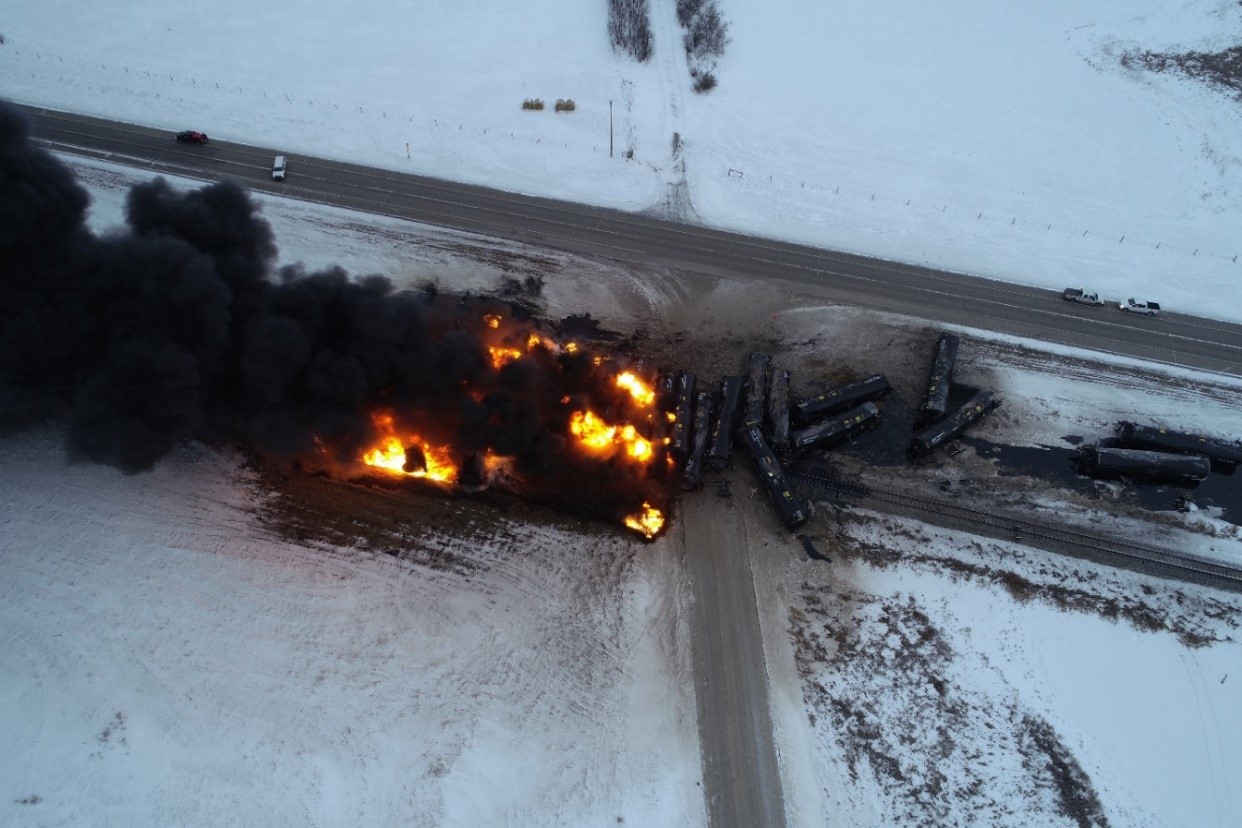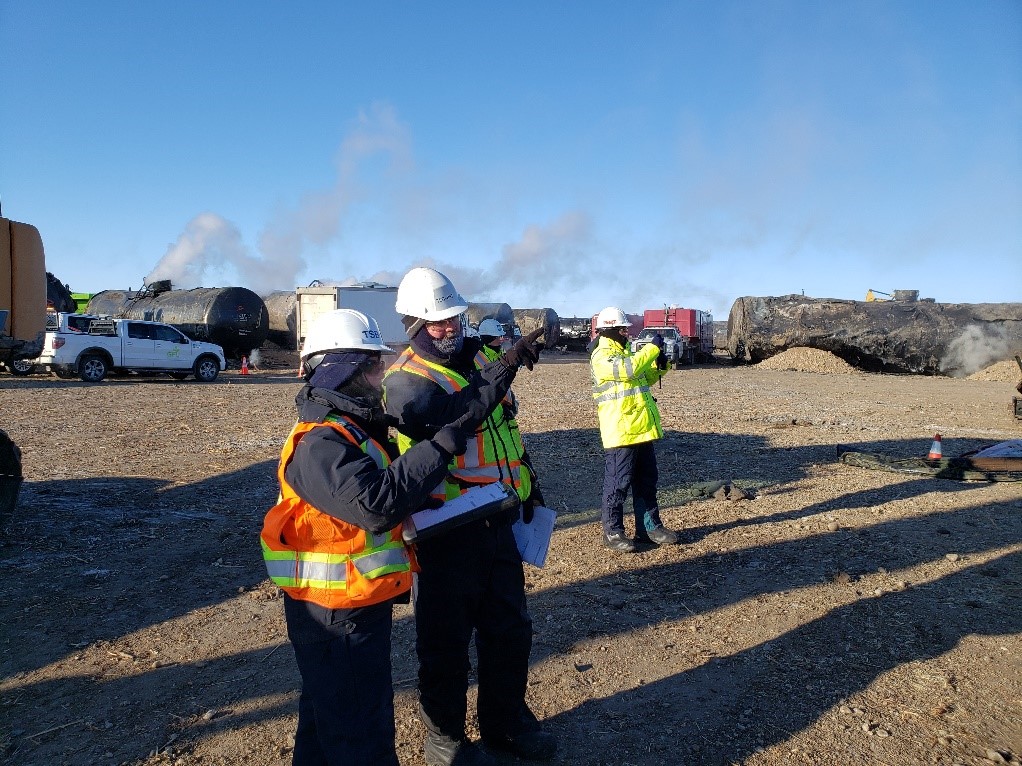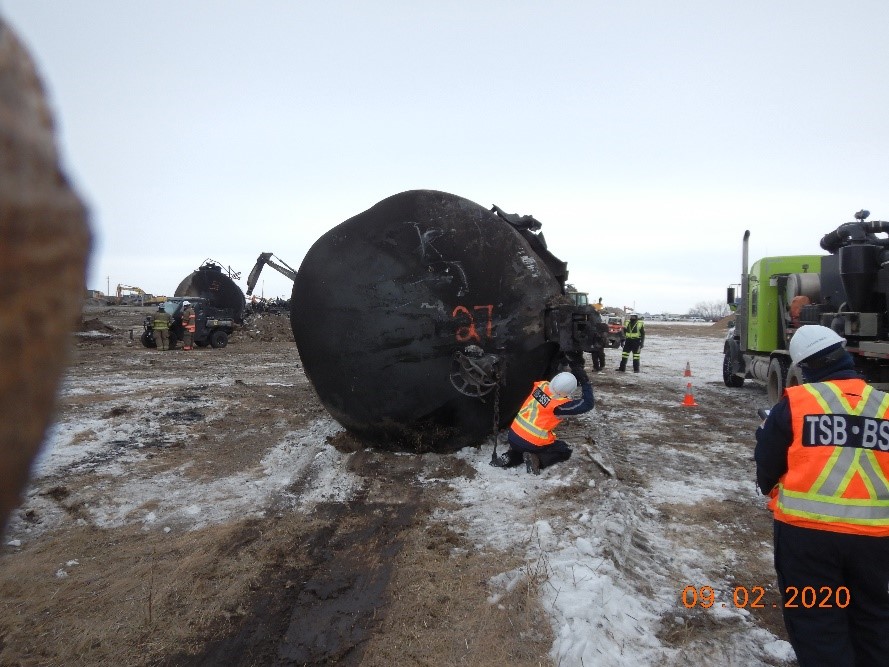Main-track train derailment
Canadian Pacific Railway, Mile 43.4, Sutherland Subdivision, Near Guernsey, Saskatchewan
The occurrence
Please note that the following information is preliminary and subject to change as the TSB continues its investigation.
On , a Canadian Pacific Railway (CP) crude oil unit train was proceeding eastward at about 42 mph on the CP Sutherland Subdivision. The train originated at Rosyth, Alberta, and was destined for Stroud, Oklahoma, USA. At 0615 Central Standard Time, the train experienced a train-initiated emergency brake application at Mile 43.4, about 1 1/2 miles west of Guernsey, Saskatchewan. Subsequent examination identified that 32 tank cars (Lines 32 – 63 inclusive) had derailed. Several tank cars were breached and an undetermined amount of petroleum crude oil product was released. The product ignited and a pool fire ensued involving a number of tank cars. There were no injuries reported. As a precaution, the Reeve of the town of Guernsey required the evacuation of about 85 people. The temperature at the time of the accident was about −18°C.
What we know
The train crew was composed of a locomotive engineer and a conductor. The train consisted of 2 distributed-power locomotives (1 on the head-end and 1 on the tail-end), a covered hopper car loaded with sand located in position 2, followed by 104 tank cars loaded with petroleum crude oil (UN1267, Class 3 PG I) and another covered hopper loaded with sand located the 107th position (108 rolling stock in total). The train weighed 14896 tons and was 6445 feet long.
The derailed tank cars were all DOT 117J100-W tank cars. The tank cars located from line 32 to 63 (32 cars) derailed. One derailed tank car that remained upright was otherwise unaffected and was subsequently re-railed. Of the remaining 31 derailed cars, about 19 derailed cars were involved in a pool fire from released product west of the crossing, while an estimated 12 cars derailed east of the crossing but were not directly involved in the fire.
To date, there have been no mechanical defects observed that could be considered causal. A review of the locomotive event recorder download determined that the train was handled in accordance with regulatory and company requirements.
The type of petroleum crude oil involved in this occurrence had properties consistent with petroleum crude oil that the TSB has evaluated in previous investigations involving crude oil.Footnote 1
Work done to date and ongoing
The investigation is currently in the field phase. Three TSB investigators are working alongside investigators from the US National Transportation Safety Board (NTSB) and the tank car manufacturer (Trinity) to gather information from the occurrence site.
Each tank car must be cleaned, purged, and staged prior to inspection. As of 12 February 2020, about 17 of the derailed cars have been examined, with several cars exhibiting breaches.
A record of any product recovered during site remediation will be maintained in order to more accurately determine how much product was released to ground or atmosphere. The product appeared to be primarily contained in a large ditch between the rail line and Highway 16 to the north of the rail line. It does not appear that any waterways were affected. A more precise estimate of the amount of product lost will be available once the site work is complete.
Next steps
There is significant industry interest in documenting the performance of the DOT 117J100-W tank cars (containment integrity and fire resistance). Detailed site examination of all of the derailed tank cars will continue, in challenging conditions, until completed.
Once site work is complete, all available information will be reviewed in order to make a more accurate assessment of the tank car damage sustained and the amount of product released. This work, will take some time.
Any tank car and track components of interest that are recovered from the site will be sent to the TSB Engineering Laboratory in Ottawa for detailed analysis.
Safety communications
Rail Safety Advisory 617-02-20: Modifying key train speed based on various train risk profiles
Rail Safety Advisory 617-03/20: Enhanced track standards for key routes
Media materials
Deployment notice
TSB deploys a team of investigators to a train derailment near Guernsey, Saskatchewan
Winnipeg, Manitoba, 6 February 2020 – The Transportation Safety Board of Canada (TSB) is deploying a team of investigators to the site of a derailment involving a Canadian Pacific Railway train near Guernsey, Saskatchewan. The TSB will gather information and assess the occurrence.
Investigation information
R20W0025
Main-track train derailment
Canadian Pacific Railway, Mile 43.4, Sutherland Subdivision, Near Guernsey, Saskatchewan
Download high-resolution photos from the TSB Flickr page.
Class of investigation
This is a class 3 investigation. These investigations analyze a small number of safety issues, and may result in recommendations. Class 3 investigations are generally completed within 450 days. For more information, see the Policy on Occurrence Classification.
TSB investigation process
There are 3 phases to a TSB investigation
- Field phase: a team of investigators examines the occurrence site and wreckage, interviews witnesses and collects pertinent information.
- Examination and analysis phase: the TSB reviews pertinent records, tests components of the wreckage in the lab, determines the sequence of events and identifies safety deficiencies. When safety deficiencies are suspected or confirmed, the TSB advises the appropriate authority without waiting until publication of the final report.
- Report phase: a confidential draft report is approved by the Board and sent to persons and corporations who are directly concerned by the report. They then have the opportunity to dispute or correct information they believe to be incorrect. The Board considers all representations before approving the final report, which is subsequently released to the public.
For more information, see our Investigation process page.
The TSB is an independent agency that investigates air, marine, pipeline, and rail transportation occurrences. Its sole aim is the advancement of transportation safety. It is not the function of the Board to assign fault or determine civil or criminal liability.


